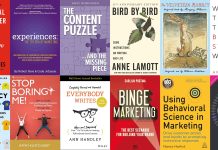Have you heard?
Listener-friendly content formats such as podcasts, audiobooks and sound snippets increase the emotional appeal of your stories and strengthen marketing performance.
Think about it. How often do you get your audience's full attention?
“Throughout your workday, you're bombarded with requests and pings on your devices while you're in 'distract and move on mode,'” says Jeanniey Walden, CMO of Rite Aid and host of the popular podcast Liftoff Journeys.
“But when you listen to audio, whether it's a podcast or an audiobook, you're most likely in a transitional or relaxed state. At that point, it's just you and the content.”
You need to develop a strategy to stand out from the crowd in a crowded content market and create realistic expectations about the value audio can provide.
Here are some expert opinions and advice on content creation and marketing strategies that include podcasting, sonic branding, and sound snippets.
How to decide if you want to start a branded podcast
According to EMARKETER's June 2024 industry forecast, U.S. podcast listeners will tune in for an average of 50 minutes per day.
“People love multitasking, and audio is the most passive way to learn and consume content,” says A. Lee Judge, co-founder and CMO of audio and video production agency Content Monsta. “You can listen to the podcast while taking a walk or doing everyday tasks.”
And you can reuse podcast assets, increasing the value of your production investment. For example, you can edit a longer conversation into short snippets for use on social media. Or you can extract verbal testimonials from the show transcript to reuse on websites and in marketing campaigns.
“The podcast is not the final product. The podcast is a source of content,” says Lee.
However, a podcast may not be ideal for every marketing goal.
“If you already have a passive audience or a unique premise that you want to make public (similar to a book), you may want to start a show,” says Jay Acunzo, host of the podcast “How Stories Happen” and co-founder of Creator Kitchen.
On the other hand, a podcast may not be a good choice if your main goal is to grow your audience. “The podcast itself doesn't spread like other forms of content. The host has to go out and promote the show, like an actor promotes a movie or an author promotes a book,” says Jay.
To create a successful show, Jay recommends investing in these critical elements:
- A well-developed, perspective-conveying premise
- An irresistible format that makes people stay until the end of the episode
- Trustworthy, entertaining talent
Just don't expect to be able to compete with celebrity podcasters like Steven Bartlett or Anna Faris.
Lee Judge explains: “If you sell hinges for industrial doors, your entire market may only be 100,000 people.”
Don't rely solely on traditional podcast metrics to assess the marketing impact of your podcasts. For example, one of Lee's clients reported a significant increase in inbound inquiries, even though her podcast analytics data didn't reflect that success.
“If she had gone by what her podcast analytics were showing, she would have thought the show wasn't working. But when people started telling her, 'I heard you here. I heard you there,' she knew it was working,” Lee says.
If you don't have the resources or budget to host a show, you can suggest company thought leaders as potential guests on other industry podcasts – or share your content as a show sponsor.
Should you invest in sonic branding?
When certain sounds or musical triggers automatically make your audience think of your company, that’s sonic branding in action.
“Sonic branding is a system of strategically designed sounds that evoke feelings in people about a brand or experience,” says John Taite, EVP of global brand partnerships at Made Music Studio. “We often say that people think about what they see, but feel what they hear.”
An instantly recognizable sound offers real marketing power.
“It's a subconscious memory trigger that kicks in when you make a purchase decision – whether it's a car or a candy bar,” says John. “Every brand sound or music leaves a long-term impression with the consumer – from advertising to social content to activations.”
John should know: his company is behind Cricket Wireless's signature beep, Nature Valley's “Call of the Crunch” whistle, and the “Cinnamon Toast Crunch” sound.
Whether you're a B2B or B2C brand, big or small, your business probably makes noise. But unless it's done intentionally, it's just noise, says Roscoe Williamson, global creative strategy & innovation director at MassiveMusic, which creates music and soundscapes for brands.
Roscoe cites his team’s work with TikTok as one of his favorite examples of the power of sonic branding:
His team developed the now ubiquitous sound logo that appears on all TikTok content pushed outside the site — in other words, millions of videos per week — and has now become TikTok's signature sound.
Sonic branding includes using sound for social media touchpoints, audio advertising, and in-person experiences (such as trade shows or in-store shopping), as well as using product sounds as alerts when a task is completed or an error has occurred.
Choosing the right sound palette for your brand starts with setting guidelines for how you want to sound and how you don't want to sound.
But if sonic branding isn't taken seriously or done right, it can damage consumers' perceptions of your brand. “Just ask any of the 15 brands using the sound of a doorbell on the radio right now,” says John Taite of Made Music Studio. “You can't stand out from the crowd if you're the crowd.”
Add audio to existing content
If podcasts and sonic branding initiatives aren't a strategic fit, it's worth exploring other approaches. For example, you can use AI automation to efficiently create audio content or integrate audio features into your existing stories.
Ann Handley, author, speaker and the world's first “Chief Content Officer,” sees the ease of working with the latest technology as “an opportunity to use audio to create a richer, more immersive customer experience and a deeper connection with the audience.”
Brands can also give their Reels, TikTok videos and text-based content an audible upgrade using AI-generated audio overlays.
Lee says AI can be a good substitute for human talent when you don't have the resources. He uses this analogy: “AI is like a replacement recording. You can watch recorded music videos, but it's not like a concert.”
However, AI can help in other ways.
“AI can translate audio data into different languages and make it accessible to the world’s population in a way that has never been possible before,” emphasizes Jeanniey Walden of Rite Aid.
Let your audience hear the voice of your brand
As you prepare your strategy, consider turning up the volume to invite people to gather and listen. Podcasts, audible logos, and adding music and sound to existing content all help deepen relationships.
Remember: “Audio is about resonance, not reach,” says Jay Acunzo. “Focus on activating existing audiences and turning them into superfans.”
A version of this article appeared in the August 2024 issue of Chief Content Officer.
Get more advice from Chief Content Officer, a monthly publication for content leaders. Subscribe today to get it in your inbox.
HANDPICKED RELATED CONTENT:

![Like a brand, marketing attribution puzzle solved [Video]](http://blog.5gigbucks.com/wp-content/uploads/2025/03/Like-a-brand-marketing-attribution-puzzle-solved-Video-218x150.png)




